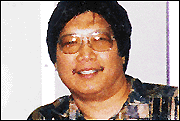Advertisement - Click to support our sponsors.


View Point
THE University of Hawaii's Institute for Astronomy and observatories may feel relieved that the Board of Regents salvaged their ill-conceived master plan for Mauna Kea, but the plan's still unfixed defects will be the source of conflict for years to come. This will further divide the Big Island community, eventually scaring off the very international astronomy development that UH wants to attract. Astronomers leave
residents in the darkAll this could have been avoided had the regents continued their constructive discussions with community members. But their impatience to "move on" halted whatever progress had been made, and they approved a plan that Big Islanders will not accept.
Despite important last-minute revisions to the plan, four fundamental defects remain:
Inclusion of 21 new telescopes or telescope elements (including the six Keck "outriggers" and 12 additional Smithsonian antennas).
Public access restrictions beginning in December of this year.
An inadequate and unprofessional environmental impact statement written (and signed by the governor) before the master plan was finished.
No observatory user fees to pay for environmental and cultural protections.
Because of these defects, UH and the observatories can expect deepening resentment and further public opposition, as well as litigation. Here are questions for the public to ask:
Whose mountain is Mauna Kea? Ours or the international astrono-mers'? Steps limiting public access to the summit will be taken soon, including no access at night, a new ranger-manned "control point" at Hale Pohaku to register visitors (and perhaps collect entrance fees), the immediate prohibition of two-wheel-drive vehicles, and likely prohibition of all private vehicles once a shuttle system (with riding fees) is established.
When are the astronomers going to admit the potential damage of their big arrays? After the regents meeting, news stories -- apparently relying on inaccurate statements by institute and UH officials -- announced that only three more telescopes would be built on the mountain, ignoring the fact that 18 other telescope elements were also incorporated into the plan as new "expansions." These six Keck "outriggers" and 12 additional Smithsonian radio telescopes engender a far greater land impact than the other three telescopes and represent the possibility of unlimited array growth in the future.
In a Jan. 7 letter to the regents, Hawaiian elders and cultural experts appointed by Sen. Daniel Inouye to advise UH urged the condemnation and dismantling of the Smithsonian array because of its "intrusive impact on the cultural environment identified with the goddess Poli'ahu."
Doesn't U.S. environmental law apply to observatory projects on Mauna Kea? The University of California, Caltech and NASA continue to ignore the National Environmental Policy Act, which requires preparation of an EIS for any project with a "substantial federal involvement."
The precedent for this lawlessness was established with the Smithsonian array and the Gemini Telescope, neither of which prepared the obligatory environmental analyses. Nor did they follow federal laws requiring consultations with Hawaiians.
Will the Mauna Kea observatories ever put their money where their mouths are? One after another, their officers got up at the regent meetings to assure the public that they really did care about islanders' concerns.
Yet they have universally opposed observatory user fees to pay for mountain protections. They seem unable to grasp the hypocrisy of their position. The reality is that Hawaii's taxpayers are going to foot the bill.
Will Big Islanders have any say about whether laser beams are allowed to pollute the night sky above Mauna Kea? Astronomers expect to soon start using lasers to maximize the effectiveness of their adaptive optics systems, and yet they have never bothered to ask Big Islanders how they feel about having all those colored lasers shooting up from the summit.
Astronomers assume their mission -- described in religious terms by officials from Keck and Smithsonian -- is far more important than anything local people feel about their mountain.
Big Islanders were counting on the regents to soften those ambitions, but our hope was lost in the board's premature approval of the plan. Now we're all going to pay for it.
Nelson Ho lives in Hilo at the foot of Mauna Kea
and serves as conservation chairman of the
Sierra Club's Hawaii Chapter.